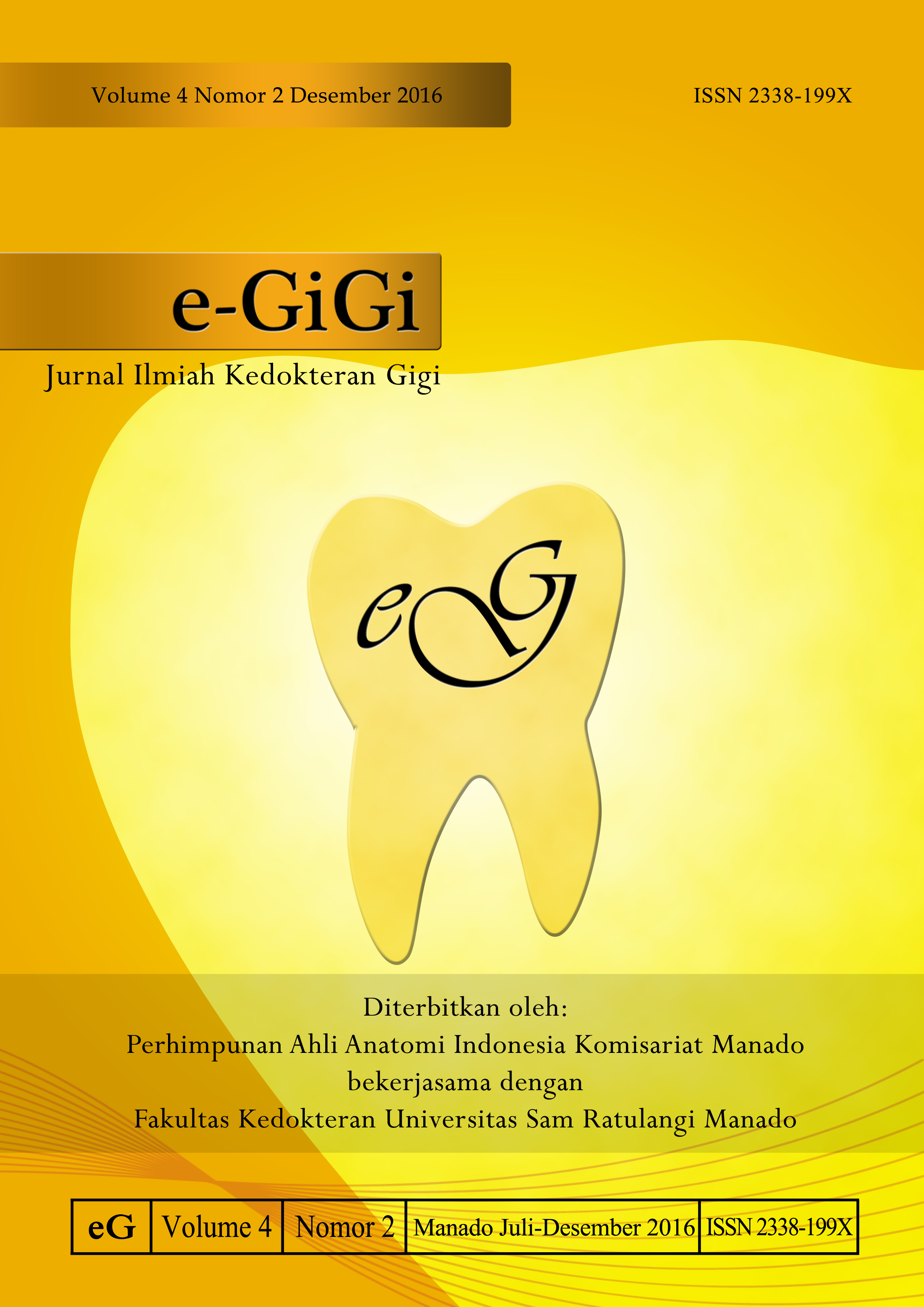Hubungan perasaan takut anak terhadap perawatan gigi dengan kebersihan gigi dan mulut di RSGM Unsrat Manado
DOI:
https://doi.org/10.35790/eg.4.2.2016.13768Abstract
Abstract: Child fear often becomes a barrier for dentists to provide optimal care. Therefore, it is important for the dentists to establish good relationship with patients, especially children. Children who have positive interaction with the dentists can handle their fears and will not be afraid to the dentists, so they are expected to have good oral hygiene. This study was aimed to analyze the relationship beetween children’s feeling of fear against dental treatment and their oral hygiene at Dental Hospital University of Sam Ratulangi. Samples were children aged 6-12 who had received dental treatment before. This was a descriptive analytical study with a cross sectional design. Data were obtained by using questionnaires and examination of OHIS. The results showed that of the 35 respondents, 23 children (65.7%) were not afraid of dental treatment (65,7%), meanwhile 12 children (34.3%) were afraid of dental treatment. There were 28 children (80%) that preferred female dentists to male dentists menawhile 7 children (20%) were the opposites. There were 23 children (65.7%) that liked dentists who used self protective equipment and 12 children (34.3%) did not. There were 21 children (60%) that had good OHI-S and 14 children (40%) that had moderate OHI-S. The Fisher alternative test showed a sinificancy of 1.000 for 2-sided (two tail) and 0.583 for 1-sided (one tail) (p˃0.05) Conclusion: There was no relationship between children’s feelings of fear against dental treatment and oral hygiene.
Keywords: feelings of fear, dental treatment, oral hygiene
Abstrak: Perasaan takut dan cemas pada anak sering menjadi penghalang bagi dokter gigi untuk memberikan perawatan yang optimal. Oleh karena itu, dokter gigi perlu menjalin hubungan baik dengan pasien khususnya pasien anak. Anak yang memiliki interaksi positif terhdap dokter gigi dapat mengatasi rasa takutnya sehingga mereka tidak akan takut ke dokter gigi dan memiliki kesehatan gigi dan mulut yang baik. Penelitian ini bertujuan untuk menganalisis hubungan antara rasa takut pada anak terhadap perawatan gigi dengan kebersihan gigi dan mulut di RSGM Unsrat. Sampel penelitian ialah anak berusia 6-12 tahun yang sudah pernah menerima perawatan gigi sebelumnya. Jenis penelitian ialah deskriptif analitik dengan desain potong lintang. Pengumpulan data menggunakan pengisian kuesioner dan pemeriksaan OHIS. Hasil penelitian menunjukkan dari 35 responden, yang tidak takut terhadap perawatan gigi 23 anak (65,7%) dan yang takut terhadap perawatan gigi 12 anak (34,3%). Yang memilih dirawat oleh dokter gigi perempuan 28 anak (80%) sedangkan yang memilih dirawat dokter gigi laki-laki 7 anak (20%). Yang menyukai dokter gigi menggunakan pelindung diri sebanyak 23 anak (65,7%) dan yang tidak menggunakan pelindung diri 12 anak (34,3%). Yang memiliki OHI-S baik 21 anak (60%) dan yang memiliki OHI-S sedang 14 anak (40%). Hasil uji alternatif Fisher mendapatkan nilai signifikansi 1,000 untuk 2-sided (two tail) dan 0,583 untuk 1-sided (one tail) (p ˃0,05) Simpulan: Tidak terdapat hubungan antara rasa takut anak terhadap perawatan gigi dengan kebersihan gigi dan mulut.
Kata kunci: perasaan takut, perawatan gigi, kebersihan gigi dan mulut
Downloads
How to Cite
Issue
Section
License
COPYRIGHT
Authors who publish with this journal agree to the following terms:
Authors hold their copyright and grant this journal the privilege of first publication, with the work simultaneously licensed under a Creative Commons Attribution License that permits others to impart the work with an acknowledgment of the work's origin and initial publication by this journal.
Authors can enter into separate or additional contractual arrangements for the non-exclusive distribution of the journal's published version of the work (for example, post it to an institutional repository or publish it in a book), with an acknowledgment of its underlying publication in this journal.
Authors are permitted and encouraged to post their work online (for example, in institutional repositories or on their website) as it can lead to productive exchanges, as well as earlier and greater citation of the published work (See The Effect of Open Access).






